A Novel Approach to Inhibit Intergranular Corrosion in Ferritic Stainless Steel Welds Using High-Speed Laser Cladding
Abstract
:1. Introduction
2. Materials and Methods
2.1. Sheet and Powder Materials
2.2. Laser Welding and High-Speed Laser Cladding
2.3. Corrosion Testing
2.4. Specimen Characterization
2.4.1. Microstructural Characterization and Microscopy
2.4.2. Mechanical Testing
3. Results and Discussion
3.1. Metallurgy of Laser-Cladded Welds
3.2. Influence on Corrosion Resistance
4. Conclusions
Author Contributions
Funding
Data Availability Statement
Acknowledgments
Conflicts of Interest
References
- Kaesche, H. Die Korrosion der Metalle: Physikalisch-Chemische Prinzipien und Aktuelle Probleme, 3rd ed.; Klassiker der Technik; Springer: Berlin/Heidelberg, Germany, 2011. [Google Scholar]
- Wendler-Kalsch, E.; Gräfen, H. Korrosionsschadenkunde, nachdr. der 1. aufl. 1998 ed.; Klassiker der Technik; Springer Vieweg: Berlin/Heidelberg, Germany, 2012. [Google Scholar]
- Kämmerer, B. Abhängigkeit der Korrosionsbeständigkeit von der Chemischen Oberflächenzusammensetzung von Chromstählen; Universität Augsburg: Augsburg, Germany, 2012. [Google Scholar]
- Pedeferri, P. Corrosion Science and Engineering; Engineering Materials; Springer International Publishing: Cham, Switzerland, 2018. [Google Scholar] [CrossRef]
- Newberg, R.T.; Uhlig, H.H. Stress Corrosion Cracking of 18% Cr Ferritic Stainless Steels. J. Electrochem. Soc. 1972, 119, 981. [Google Scholar] [CrossRef]
- Sabioni, A.C.S.; Huntz, A.M.; Luz, E.C.D.; Mantel, M.; Haut, C. Comparative study of high temperature oxidation behaviour in AISI 304 and AISI 439 stainless steels. Mater. Res. 2003, 6, 179–185. [Google Scholar] [CrossRef] [Green Version]
- Berns, H.; Theisen, W. Eisenwerkstoffe: Stahl und Gusseisen, 4th ed.; Springer: Berlin/Heidelberg, Germany, 2008. [Google Scholar]
- Amuda, M.O.H.; Mridha, S. An Overview of Sensitization Dynamics in Ferritic Stainless Steel Welds. Int. J. Corros. 2011, 2011, 305793. [Google Scholar] [CrossRef]
- Čihal, V. Intergranular Corrosion of Steels and Alloys, revised and extended edition; Materials Science Monographs; Elsevier: Amsterdam, The Netherlands, 1984; Volume 18. [Google Scholar]
- Strehblow, H.H. Nucleation and Repassivation of Corrosion Pits for Pitting on Iron and Nickel. Mater. Corros. Korros. 1976, 27, 792–799. [Google Scholar] [CrossRef]
- Szummer, A.; Szklarska-Smialowska, Z.; Janik-Czachor, M. Electron microprobe study of the corrosion pits nucleation on Fe-16cr single crystals. Corros. Sci. 1968, 8, 827-IN11. [Google Scholar] [CrossRef]
- Forchhammer, P.; Engell, H.J. Untersuchungen über den Lochfraß an passiven austenitischen Chrom-Nickel-Stählen in neutralen Chloridlösungen. Mater. Corros. 1969, 20, 1–12. [Google Scholar] [CrossRef]
- Smialowski, M.; Szklarska-Smialowska, Z.; Rychcik, M.; Szummer, A. Effect of sulphide inclusions in a commercial stainless steel on the nucleation of corrosion pits. Corros. Sci. 1969, 9, 123–125. [Google Scholar] [CrossRef]
- Xu, S.; Wu, X.Q.; Han, E.H.; Ke, W.; Katada, Y. Crack initiation mechanisms for low cycle fatigue of type 316Ti stainless steel in high temperature water. Mater. Sci. Eng. A 2008, 490, 16–25. [Google Scholar] [CrossRef]
- Gateman, S.M.; Stephens, L.I.; Perry, S.C.; Lacasse, R.; Schulz, R.; Mauzeroll, J. The role of titanium in the initiation of localized corrosion of stainless steel 444. NPJ Mater. Degrad. 2018, 2, 1080. [Google Scholar] [CrossRef] [Green Version]
- Bargel, H.J.; Schulze, G.; Hilbrans, H. Werkstoffkunde, 10th ed.; VDI-Buch; Springer: Berlin/Heidelberg, Germany, 2008. [Google Scholar] [CrossRef]
- Herbsleb, G. Interkristalline Korrosion ferritischer Chromstähle mit rd. 17 Gew.-% Chrom nach Glühen im Temperaturbereich um 500 °C. Mater. Corros. Korros. 1978, 29, 321–325. [Google Scholar] [CrossRef]
- Lee, J.B.; Smith, J.F.; Geiger, A.L.; Kah, D.H. An Analytical Electron Microscope Examination of Sensitized AISI 430 Stainless Steel. Corrosion 1985, 41, 76–80. [Google Scholar] [CrossRef]
- Huang, X.z.; Wang, D.; Yang, Y.T. Effect of Precipitation on Intergranular Corrosion Resistance of 430 Ferritic Stainless Steel. J. Iron Steel Res. Int. 2015, 22, 1062–1068. [Google Scholar] [CrossRef]
- van Niekerk, C.J.; Du Toit, M. Sensitization behaviour of 11–12% Cr AISI 409 stainless steel during low heat input welding. J. South. Afr. Inst. Min. Metall. 2011, 111, 243–256. [Google Scholar]
- van Niekerk, C.J.; Du Toit, M.; Erwee, M.W. Sensitization Of Aisi 409 Ferritic Stainless Steel During Low Heat Input Arc Welding. Weld. World 2012, 56, 54–64. [Google Scholar] [CrossRef]
- Du Toit, M.; Naudé, J. The influence of stabilization with TITANIUM on the HEAT-AFFECTED ZONE SENSITIZATION of 11 to 12% chromium ferritic stainless steels under low heat input welding conditions. Weld. World 2011, 55, 38–47. [Google Scholar] [CrossRef]
- Lakshminarayanan, A.K.; Balasubramanian, V. Use of DL-EPR Test to Assess Sensitization Resistance of AISI 409M Grade Ferritic Stainless Steel Joints. J. Mater. Eng. Perform. 2013, 22, 2293–2303. [Google Scholar] [CrossRef]
- de Amorim, R.A.; Lebrão, S.M.G.; Colosio, M.A.; Lara, J.A.C. Analysis of intergranular corrosion in welded joints with ferritic stainless steel ISI 409 and AISI 439 for application in vehicular exhaustion systems. In Blucher Engineering Proceedings; Editora Blucher: São Paulo, Brazil, 2018; pp. 567–574. [Google Scholar] [CrossRef]
- Herbsleb, G.; Schwenk, W. Untersuchungen über die Kornzerfallsanfälligkeit eines unstabilisierten 17%igen Chromstahles und ihre Beseitigung durch Stabilglühen. Mater. Corros. 1968, 19, 103–113. [Google Scholar] [CrossRef]
- Dilthey, U. Schweißtechnische Fertigungsverfahren 2: Verhalten der Werkstoffe Beim Schweißen, 3th ed.; VDI-Buch; Springer: Berlin/Heidelberg, Germany, 2005. [Google Scholar] [CrossRef]
- Park, J.H.; Kim, J.K.; Lee, B.H.; Seo, H.S.; Kim, K.Y. Effect of Zr addition on intergranular corrosion of low-chromium ferritic stainless steel. Scr. Mater. 2014, 76, 77–80. [Google Scholar] [CrossRef]
- Kim, J.K.; Kim, Y.H.; Lee, J.S.; Kim, K.Y. Effect of chromium content on intergranular corrosion and precipitation of Ti-stabilized ferritic stainless steels. Corros. Sci. 2010, 52, 1847–1852. [Google Scholar] [CrossRef]
- Kim, J.K.; Kim, Y.H.; Lee, B.H.; Kim, K.Y. New findings on intergranular corrosion mechanism of stabilized stainless steels. Electrochim. Acta 2011, 56, 1701–1710. [Google Scholar] [CrossRef]
- Li, H.b.; Jiang, Z.h.; Feng, H.; Zhu, H.c.; Sun, B.h.; Li, Z. Corrosion behavior of ferritic stainless steel with 15wt% chromium for the automobile exhaust system. Int. J. Miner. Metall. Mater. 2013, 20, 850–860. [Google Scholar] [CrossRef]
- Sommer, N.; Kryukov, I.; Wolf, C.; Wiegand, M.; Kahlmeyer, M.; Böhm, S. On the Intergranular Corrosion Properties of Thin Ferritic Stainless Steel Sheets Welded by Fiber-Laser. Metals 2020, 10, 1088. [Google Scholar] [CrossRef]
- Sommer, N.; Warres, C.; Lutz, T.; Kahlmeyer, M.; Böhm, S. Transmission Electron Microscopy Study on the Precipitation Behaviors of Ferritic Stainless Steel Welds and their Implications on Intergranular Corrosion Resistance. Metals 2021. in communication.. [Google Scholar]
- Bahrami, A.; Taheri, P. A Study on the Failure of AISI 304 Stainless Steel Tubes in a Gas Heater Unit. Metals 2019, 9, 969. [Google Scholar] [CrossRef] [Green Version]
- Dahmen, M.; Rajendran, K.D.; Lindner, S. Sensitization of Laser-beam Welded Martensitic Stainless Steels. Phys. Procedia 2015, 78, 240–246. [Google Scholar] [CrossRef]
- Köse, C. Investigation on microstructure, surface and corrosion characteristics of heat treated AISI 420 martensitic stainless steel laser welds in simulated body fluid (SBF). Int. J. Electrochem. Sci. 2018, 13, 12208–12225. [Google Scholar] [CrossRef]
- Gennari, C.; Lago, M.; Bögre, B.; Meszaros, I.; Calliari, I.; Pezzato, L. Microstructural and Corrosion Properties of Cold Rolled Laser Welded UNS S32750 Duplex Stainless Steel. Metals 2018, 8, 1074. [Google Scholar] [CrossRef] [Green Version]
- Sommer, N.; Stredak, F.; Böhm, S. High-Speed Laser Cladding on Thin-Sheet-Substrates—Influence of Process Parameters on Clad Geometry and Dilution. Coatings 2021, 11, 952. [Google Scholar] [CrossRef]
- DIN. Determination of Resistance to Intergranular Corrosion of Stainless Steels—Part 2: Ferritic, Austenitic and Ferritic-Austenitic (Duplex) Stainless Steels; Beuth Verlag GmbH: Berlin, Germany, 1998; Corrosion test in media containing sulfuric acid (ISO 3651-2:1998): German version EN ISO 3651-2:1998. [Google Scholar]
- DIN. Metallic Materials—Tensile Testing—Part 1: Method of Test at Room Temperature (ISO 6892-1:2019): German Version EN ISO 6892-1:2019; Beuth Verlag GmbH: Berlin, Germany, 2020. [Google Scholar]
- Sommer, N.; Kluge, P.; Stredak, F.; Eigler, S.; Hill, H.; Niendorf, T.; Böhm, S. Additive Manufacturing of Compositionally-Graded AISI 316L to CoCrMo Structures by Directed Energy Deposition. Crystals 2021, 11, 1043. [Google Scholar] [CrossRef]
- Nowell, M.M.; Wright, S.J.; Carpenter, J.O. Differentiating Ferrite and Martensite in Steel Microstructures Using Electron Backscatter Diffraction. In Proceedings of the Materials Science & Technology Conference and Exhibition 2009, Pittsburgh, PA, USA, 25–29 October 2009; Curran: Red Hook, NY, USA, 2009. [Google Scholar]
- Helmer, H.E.; Körner, C.; Singer, R.F. Additive manufacturing of nickel-based superalloy Inconel 718 by selective electron beam melting: Processing window and microstructure. J. Mater. Res. 2014, 29, 1987–1996. [Google Scholar] [CrossRef]
- Kiran, A.; Koukolíková, M.; Vavřík, J.; Urbánek, M.; Džugan, J. Base Plate Preheating Effect on Microstructure of 316L Stainless Steel Single Track Deposition by Directed Energy Deposition. Materials 2021, 14, 5129. [Google Scholar] [CrossRef]
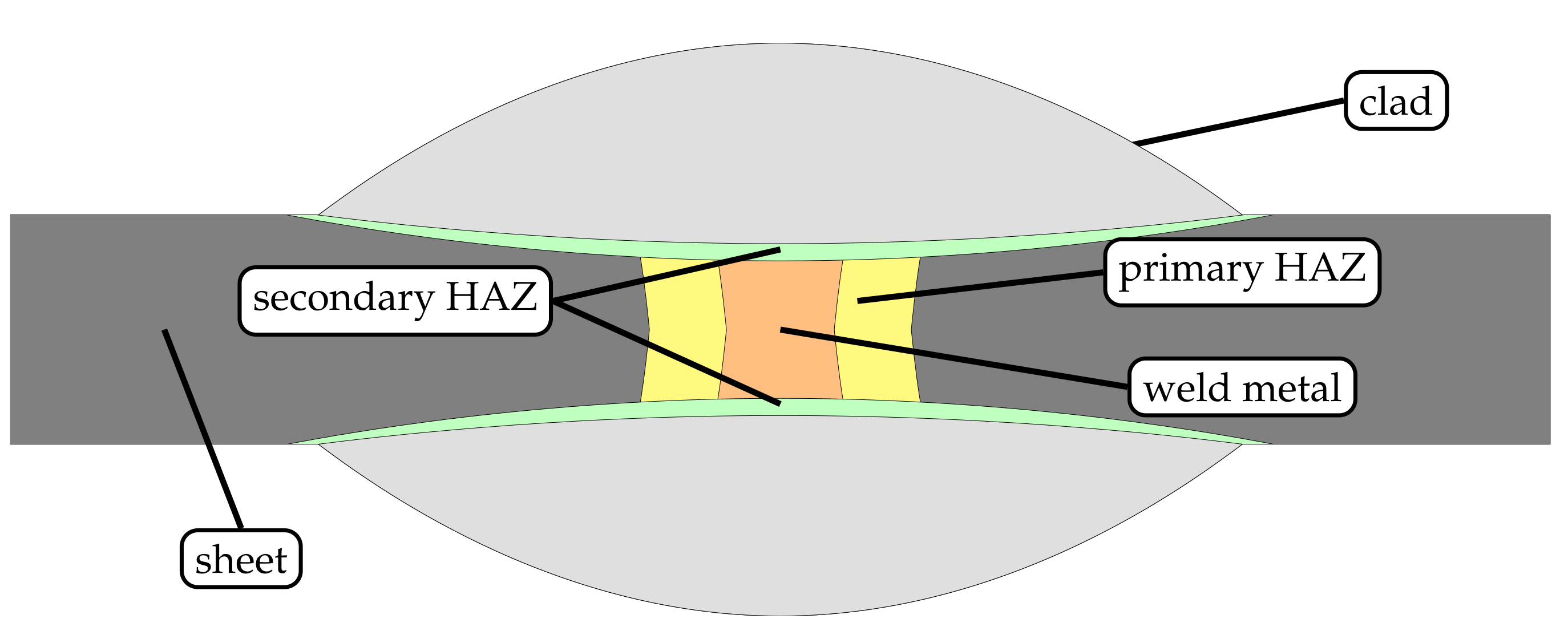



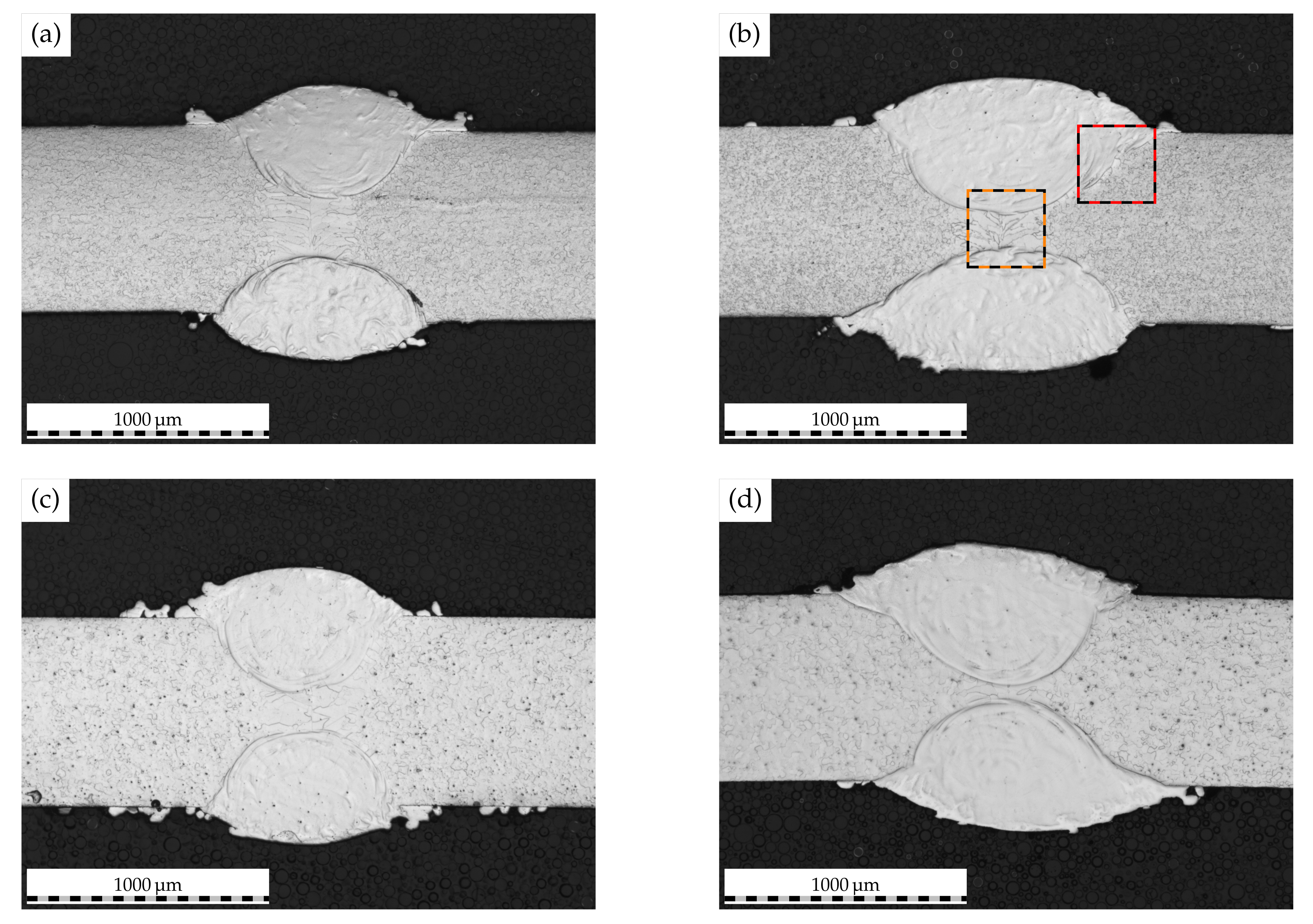

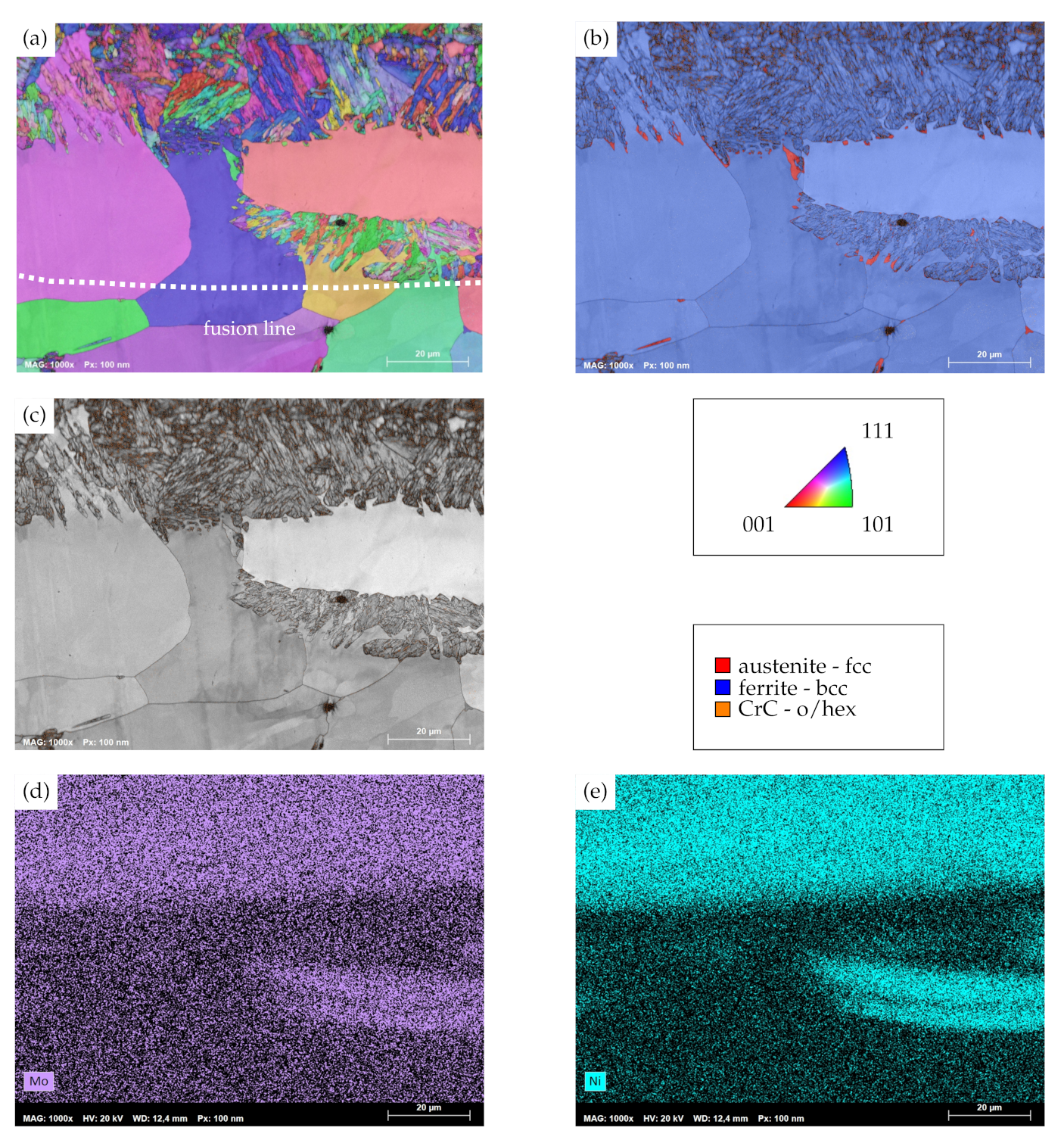





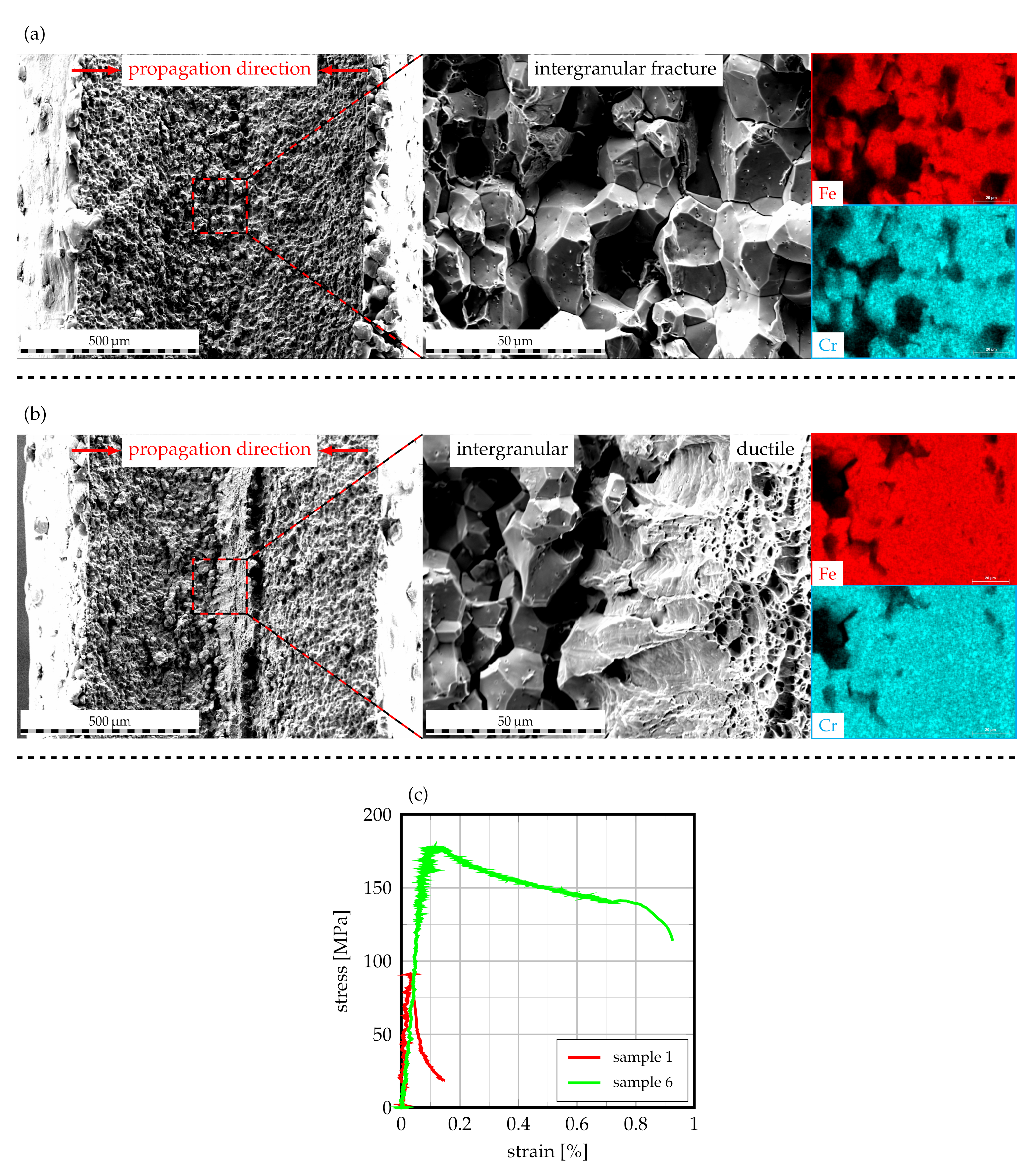
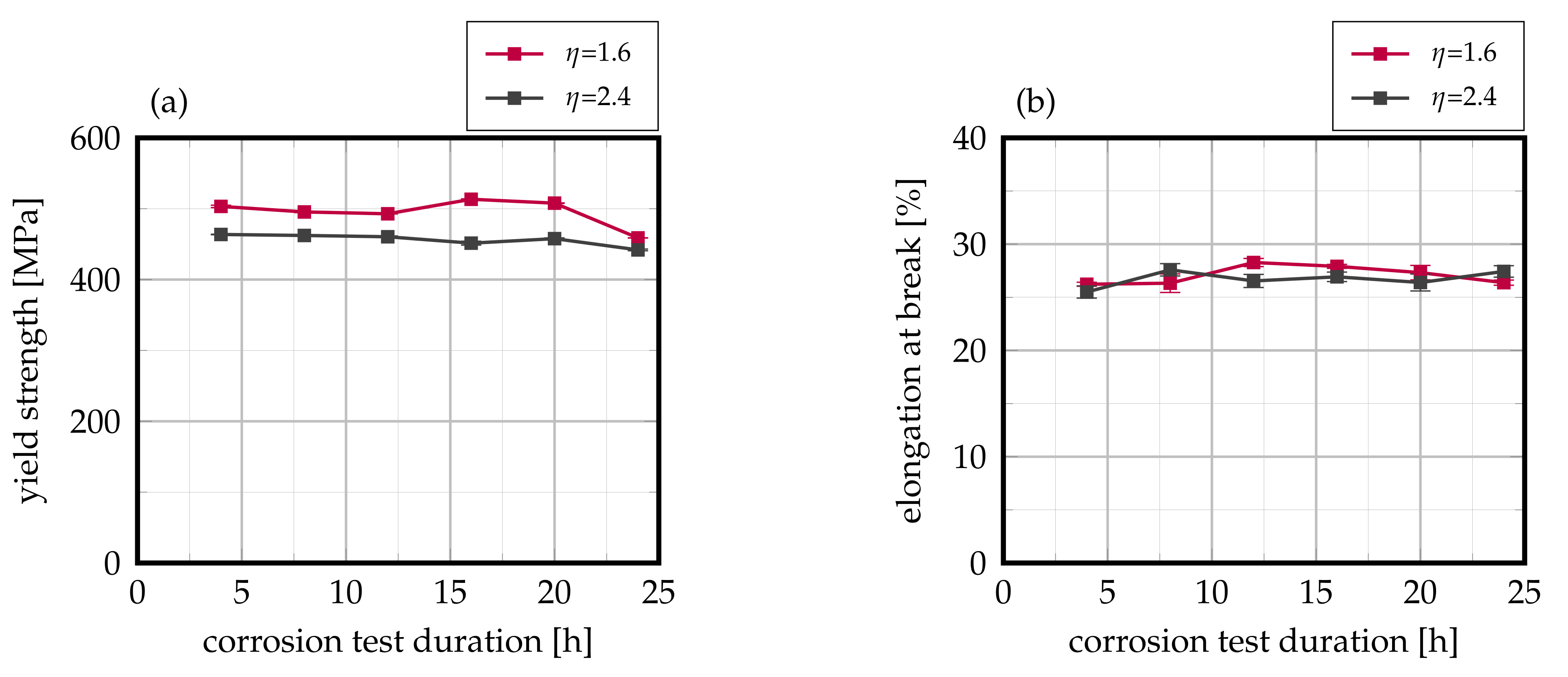

| (a) | |||||||
| Grade | Chemical Composition [] | ||||||
| C | N | Cr | Ti | Ni | Mo | Fe | |
| AISI 430 | 0.041 | 0.142 | 16.18 | 0.001 | 0.156 | 0.046 | bal. |
| AISI 430Ti | 0.018 | 0.079 | 16.18 | 0.326 | 0.260 | 0.046 | bal. |
| (b) | |||||||
| Grade | Chemical Composition [] | ||||||
| C | Mn | Cr | Mo | Ni | |||
| AISI 316L | 0.026 | 1.3 | 17.1 | 2.4 | 11.0 | ||
| Grade | Duration [h] | |||||
|---|---|---|---|---|---|---|
| AISI 430 | 2 | 4 | 6 | 8 | 10 | 20 |
| AISI 430Ti | 4 | 8 | 12 | 16 | 20 | 24 |
Publisher’s Note: MDPI stays neutral with regard to jurisdictional claims in published maps and institutional affiliations. |
© 2021 by the authors. Licensee MDPI, Basel, Switzerland. This article is an open access article distributed under the terms and conditions of the Creative Commons Attribution (CC BY) license (https://creativecommons.org/licenses/by/4.0/).
Share and Cite
Sommer, N.; Grimm, L.; Wolf, C.; Böhm, S. A Novel Approach to Inhibit Intergranular Corrosion in Ferritic Stainless Steel Welds Using High-Speed Laser Cladding. Metals 2021, 11, 2039. https://doi.org/10.3390/met11122039
Sommer N, Grimm L, Wolf C, Böhm S. A Novel Approach to Inhibit Intergranular Corrosion in Ferritic Stainless Steel Welds Using High-Speed Laser Cladding. Metals. 2021; 11(12):2039. https://doi.org/10.3390/met11122039
Chicago/Turabian StyleSommer, Niklas, Lukas Grimm, Christian Wolf, and Stefan Böhm. 2021. "A Novel Approach to Inhibit Intergranular Corrosion in Ferritic Stainless Steel Welds Using High-Speed Laser Cladding" Metals 11, no. 12: 2039. https://doi.org/10.3390/met11122039
APA StyleSommer, N., Grimm, L., Wolf, C., & Böhm, S. (2021). A Novel Approach to Inhibit Intergranular Corrosion in Ferritic Stainless Steel Welds Using High-Speed Laser Cladding. Metals, 11(12), 2039. https://doi.org/10.3390/met11122039






